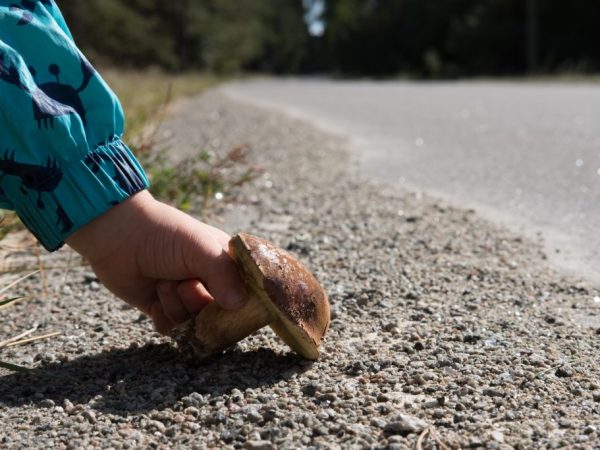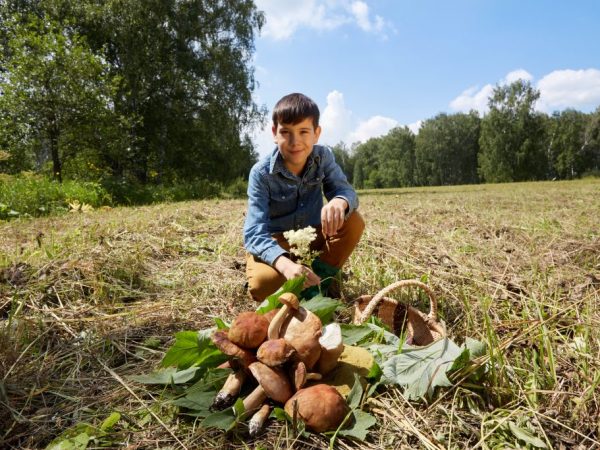Why you can't pick mushrooms near the road
Mushrooms are such a tasty, healthy and nutritious product that it is impossible to deny yourself the pleasure of enjoying these gifts of nature. And many lovers of quiet hunting, going to the seasonal collection, see mushrooms near the roads. The temptation to collect them, of course, is great, but this cannot be done. Let's see why.

Why you can't pick mushrooms near the road
Feature of mushrooms
Every mushroom picker should remember that mushrooms are much more active than other forest vegetation in absorbing both useful and harmful chemical compounds from the environment.
For example, emissions from industrial facilities, exhaust fumes from passing vehicles, chemicals sprayed over farmlands, and so on, easily get into the cap of a mushroom with precipitation. But that's not all!
The maximum amount of dangerous elements comes from the soil layer, where the mycelium grows and develops.
Fungi on the surface of the earth are only the visible part of a vast fungal organism called fruiting bodies.
Forms the fruiting bodies of the mycelium, located underground. It grows over long distances and secretes enzymes, and then absorbs organic matter from the soil layer over its entire surface. Therefore, the elements found in the soil, various in their structure and danger to the body, end up in the mushrooms.
What substances accumulate
Hazardous accumulated substances include water-soluble salts of heavy metals such as mercury (Hg), lead (Pb), cadmium (Cd), zinc (Zn), copper (Cu), manganese (Mn), selenium (Se), etc.
Also, radioactive elements such as cesium (Cs) and strontium (Sr) and pesticides, which are used to treat farm fields from pests, enter the mushrooms exclusively from the soil. For your information. Certain pesticides used in agriculture are mutagenic.
Of all the plant inhabitants of the forest kingdom, it is mushrooms that are able, like a sponge, to absorb and accumulate hazardous compounds in quantities that exceed the permissible safety limits for human life and health. Therefore, they are very often called bioaccumulators.
You should think a hundred times before putting a mushroom found near the roadway into the basket. Fungi growing along railway tracks, as well as on forest edges near agricultural fields, industrial zones and various waste dumps, fall into this category.
By the way, woody mushrooms are safer than soil ones, because accumulate harmful substances in much smaller volumes. If you are a lover of oyster mushrooms or honey agarics, then you can safely collect them even in ecologically hazardous areas.
Effects on the human body

Picking mushrooms on the sidelines is not worth it
How do mushrooms, collected in inappropriate places, affect the human body?
If you nevertheless decide to pick edible mushrooms along the road and on the edges of the forest near farms and industrial zones, then you should remember that such forest gifts have toxic, carcinogenic and mutagenic effects on the human body.
Irina Selyutina (Biologist):
Carcinogen - a chemical substance or physical agent (factor) capable of causing the development of malignant tumors when exposed to living tissue or contributing to their occurrence. To date, more than 200 substances with a carcinogenic effect are already known. The main sources of their emissions are:
- enterprises for thermal processing of coal and oil;
- auto and air transport.
The mechanism of action of carcinogens leads to the emergence of mutations as a result of irreversible changes in the hereditary apparatus.
Mutagen - a factor of any nature (physical, chemical, biological) that affects the body and causes changes in its hereditary properties at the level of gene and chromosomal mutations. There is now a list of 2,000 compounds that are known to be mutagens.
Poisoning with heavy metals and other harmful chemical compounds can be acute or chronic.
In acute - the symptomatology is violent, and in chronic - blurred and indistinct, but no less dangerous to health and life.
Poisoning symptoms may be specific to each chemical, but the big picture includes nausea or violent vomiting, heart palpitations, increased / decreased blood pressure, pupillary changes, drowsiness / lethargy, or unnatural irritability.
Poisoning symptoms
In case of general symptoms of poisoning after eating mushrooms collected from the road, it is necessary to provide first aid and take the victim to a hospital as soon as possible.
The effect of chemical elements on the body:
- Lead: causes a disorder of the central nervous system, accumulates in the kidneys, liver, bone tissues, affects the cardiovascular and endocrine systems.
- Cadmium: affects the kidneys, central nervous system, negatively affects the female and male reproductive function.
Milk mushrooms, boletus, pigs, boletus and champignons are the leaders among mushrooms in terms of the concentration of heavy metals. They are capable of accumulating colossal amounts of mercury and cadmium. This is confirmed by measurements that show that the concentration of cadmium and mercury can be tens or even hundreds of times higher than the content of these elements in the soil.
The ability of mushrooms to absorb heavy metal salts reaches its maximum value during the period of mycelium growth and active formation of fruit bodies. The concentration of heavy metals in the fruiting body always increases from stem to cap, because in it all metabolic processes occur more quickly and actively. Also, in young mushrooms, the concentration of hazardous substances is much higher than in old ones.
Radiation
Mushroom workers living in an area with an increased background radiation, another danger awaits in the forest - radiation.
Its intensity depends on various circumstances - species biological characteristics, growing conditions (composition of water and soil, climate) and the age of the mycelium.
Why are mushrooms so sensitive to radiation:
- The main chemical element in the composition of the fruiting body is potassium. It is considered a chemical similarity to the radioactive element cesium-137 (Cs-137), which is why it is especially actively absorbed by both the mycelium and the fruit bodies growing on it.
- The second radioactive element is strontium-90 (Sr-90). It is also absorbed by fungi, but much less cesium.
Do you know? Hat mushrooms with a large stem (aspen, white, Polish) are characterized by an uneven distribution of cesium-137 in their fruiting body: in the caps it will be 1.5-2 times more than in the stem.
What are mushrooms in relation to radiation
Despite the fact that fungi are considered leaders in the accumulation of radioactive substances (cesium and strontium), not all species have the same absorbing capacity.
This difference is explained by the specific features of the growth of fungi and the location of the mycelium.
Irina Selyutina (Biologist):
All edible mushrooms are divided into groups according to their ability to accumulate radionuclides:
- Batteries, or active accumulators: Polish, green and yellow-brown flywheel, bitter, common oiler, larch and granular, thin pig.
- Strong accumulators: black and white milk mushrooms, pink and white waves, ordinary russula, chanterelles, brilliant green.
- Medium storage: white, gray rows, real chanterelles, ordinary lines, marsh and common boletus boletus, aspen mushrooms and champignons.
- Discriminators: oyster mushrooms, russula, umbrella mushrooms, raincoats and autumn mushrooms.
The cleanest mushrooms in terms of radiation are arboreal. Knowing the distribution of mushrooms into such specific groups, you can navigate in the collection of mushrooms and make it safe.
Precautions
If you still want mushrooms, then when collecting and subsequent processing, you should observe the following precautions:
- do not pick up immediately after a dry period;
- carry out thorough culinary processing;
- not to visit areas with unfavorable radiation background;
- buy mushrooms only from official sellers;
- do not buy mushrooms in spontaneous markets next to roads.
Attention! Boiling mushrooms for 1 hour with a threefold water change reduces the content of heavy metals, their salts and radionuclides to acceptable limits.


